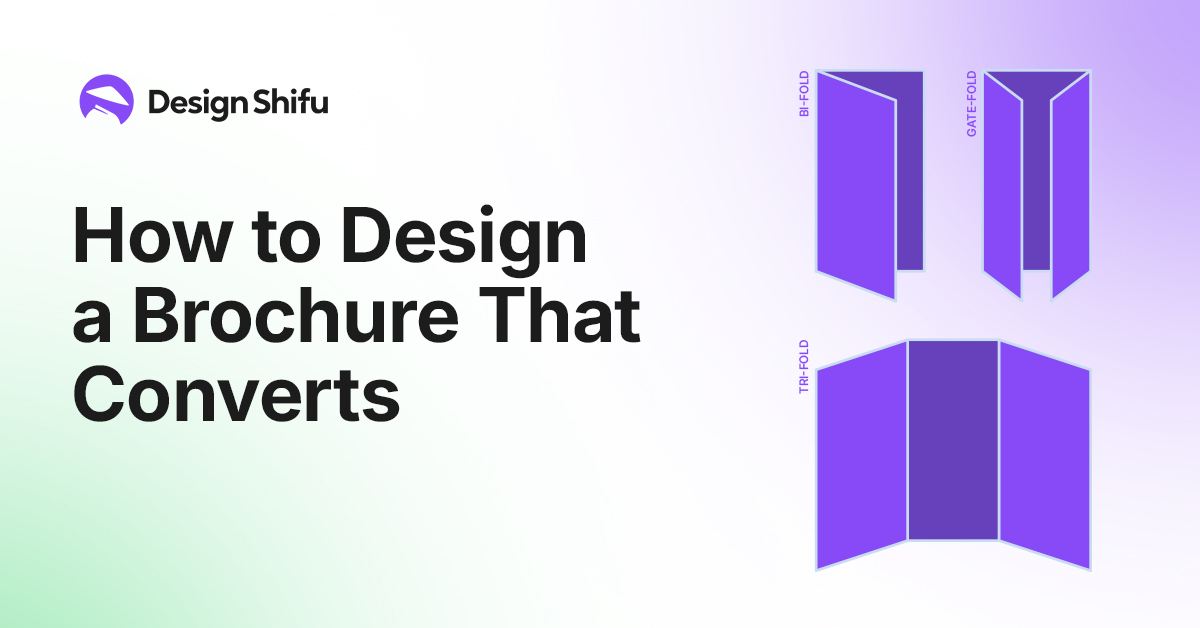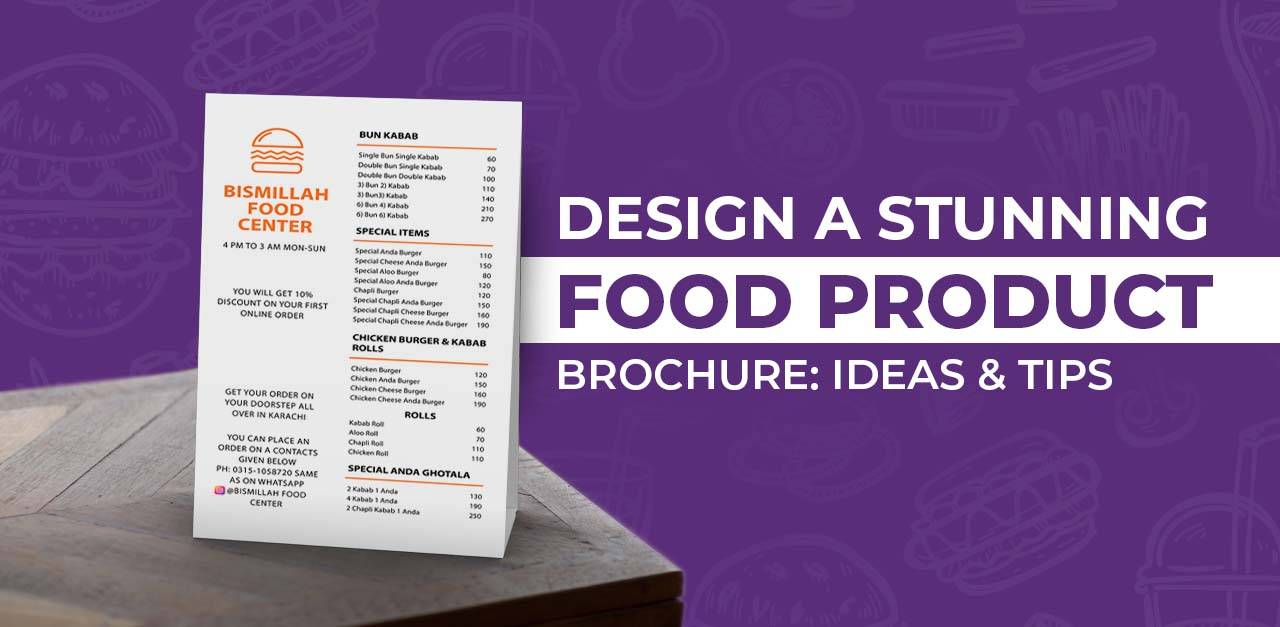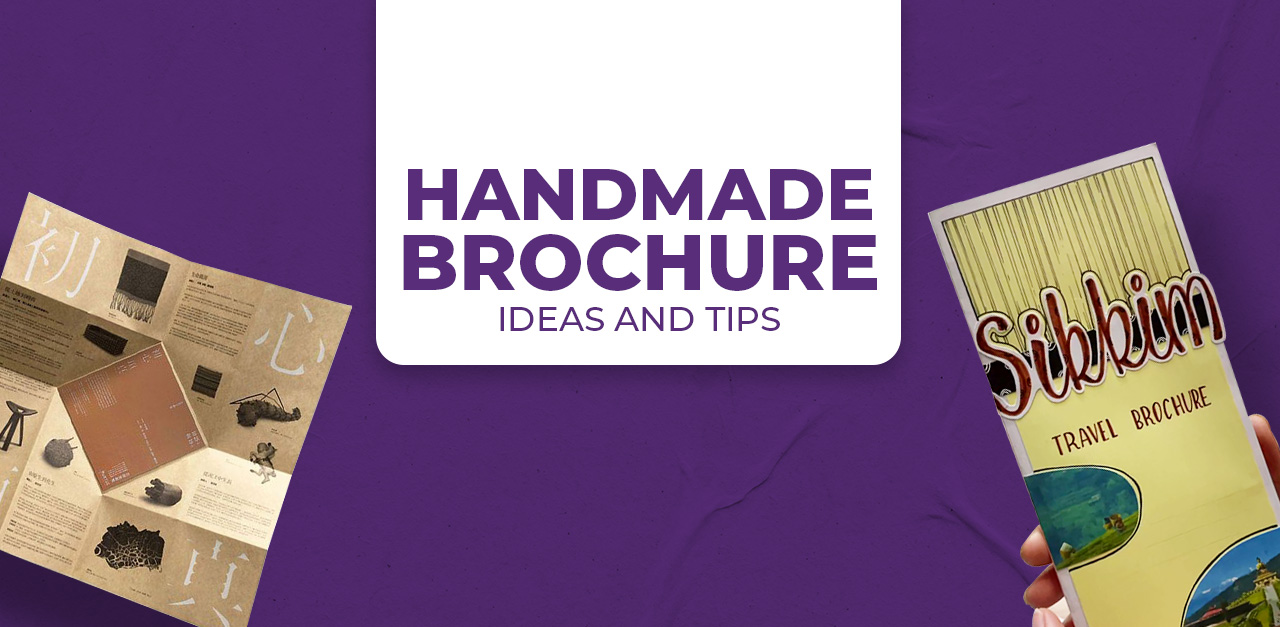Many words in the printing world, such as pamphlets and brochures, can be confusing for a layman. They are often used interchangeably in everyday conversation. This is because the layouts for pamphlets and brochures are similar and share a common goal as marketing material. But if you look closer, you will spot the dissimilarities. So now let’s answer the pamphlet vs. brochure question in detail, along with the key differences.
To understand the difference, you first need to know what is a pamphlet and a brochure separately. This write-up is a complete guide for all your queries about both terms.
TL;DR
- Pamphlets Versus Brochures Pamphlets and brochures may seem similar but they are used to different ends.
- Pamphlets are brief, inexpensive pamphlets about a single topic, for educational, awareness, or advocacy purposes.
- Brochures, however, are glossy, slick, marketing-oriented products designed to show off products, services or events with high quality images and in-depth text.
- Booklet brochures and infographic brochures are updated ingredients that allow brands to leave themselves and they information they offer in exciting and original ways.
What is a pamphlet?
A pamphlet is a small, unbound booklet or leaflet that provides information or arguments about a specific issue or topic. Pamphlets are often used for educational, promotional, or advocacy purposes. A pamphlet is generally characterized by its brevity, focused content, and concise messaging.
Variously a pamphlet may be handed out, placed in a rack for others to pick up, or used as an insert in a direct mailing campaign.
The purpose of the pamphlet is to give detailed information. They are not used to sell or advertise. Typically, pamphlets are used non-commercially, but you can use them to promote local businesses and create a brand identity as they are economical to print.
It can either be inserted with the newspaper, dropped in the mailboxes, or distributed publicly on roads. Also known as flyers and handouts, pamphlets are called polyeto in Tagalog.
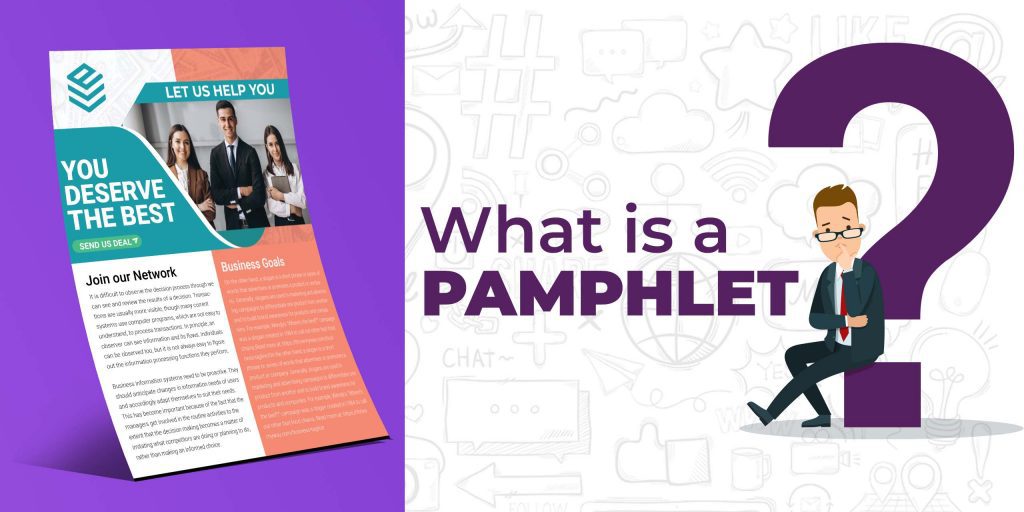
Let’s look at a few pamphlet examples to clarify the characteristics. You must have encountered them while visiting the hospital or talking with your doctor about a disease or procedure. Similarly, educational institutions can share course information.
Pamphlets are also commonly used by political parties to share their manifesto during polls. A short printed item that makes any data easier to understand, pamphlets can also be in digital form for a wider reach.
What Is in a Pamphlet?
A pamphlet usually keeps things short, clear, and to the point. Inside, you’ll often find a catchy headline, a brief explanation of the topic, a few supporting visuals, and the most important information the reader needs to know. Instead of long paragraphs, pamphlets use quick facts, small sections, and easy-to-read text so someone can understand the message in just a few seconds.
Whether it’s about a product, an event, or an awareness campaign, everything inside a pamphlet is designed to be simple, helpful, and easy to remember.
Now that we have an idea about what is a pamphlet let us understand brochures in depth.
What Is a Tri-Fold Pamphlet?
A tri-fold pamphlet is a simple three-panel leaflet that folds into three equal sections like a “Z” or a brochure you can hold in one hand. When you unfold it, you get six small panels (three on the front, three on the back) that neatly organize your information.
People love tri-fold pamphlets because they’re easy to carry, easy to read, and perfect for breaking information into small, digestible sections. Businesses often use them for product overviews, events, menus, service highlights, or quick educational content.
In short, a tri-fold pamphlet is a compact, structured way to share information without overwhelming the reader.
What is a brochure?
A brochure is a sales document, most commonly a folded booklet, that is used to promote a company, product, service, or organization to prospective customers or the public. A brochure provides a summary of key features and benefits, using a combination of text, images, and design.
Brochures accomplish the goal of attracting interest and attention on the product or service, and tends to convey the most important information about the product in a visually interesting way.
They are formal and modern ways of advertising. Also known as booklets, brochures typically contain detailed information with the intent to sell. It can take the form of a single sheet of paper folded in two, three, or multiple panels, or a bound booklet with several pages.
Designers usually print brochures with eye-catching layouts, high-resolution images, and good-quality glossy paper to enhance their appeal. If you wish to know brochure design in detail, read our detailed step-by-step guide on brochure design.
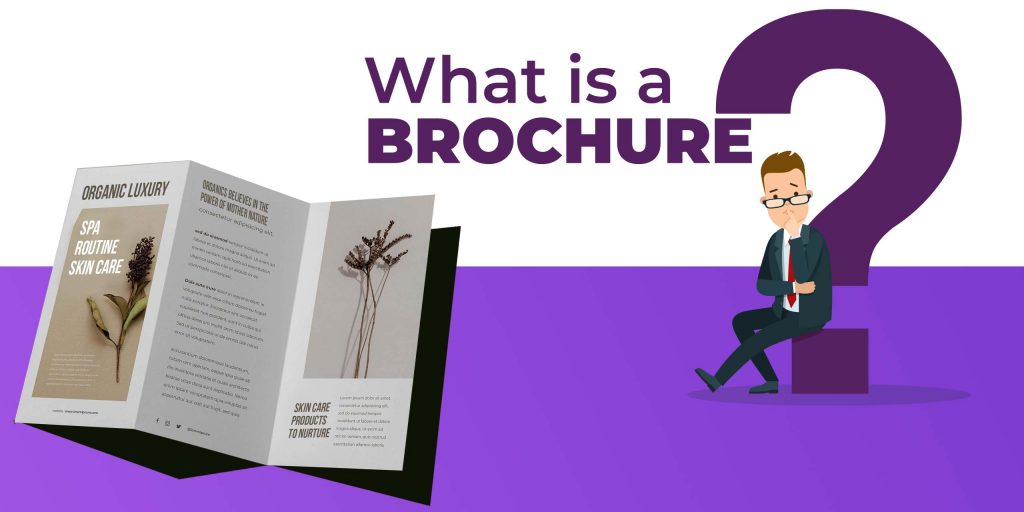
Brochures are an important marketing tool for many companies. The objective is to show the product or service of the organization in captivating form to appeal to spot the business. They are also an important way to introduce a brand to new customers and boost brand visibility.
Marketers use brochures to offer more details about events and as an invitation for them. But the clickable images, the delicious content, that are one-line long, are often easy to hook an audience with.
Common Use Cases for Brochures
Brochures are incredibly versatile and can be adapted for a wide range of purposes. For example:
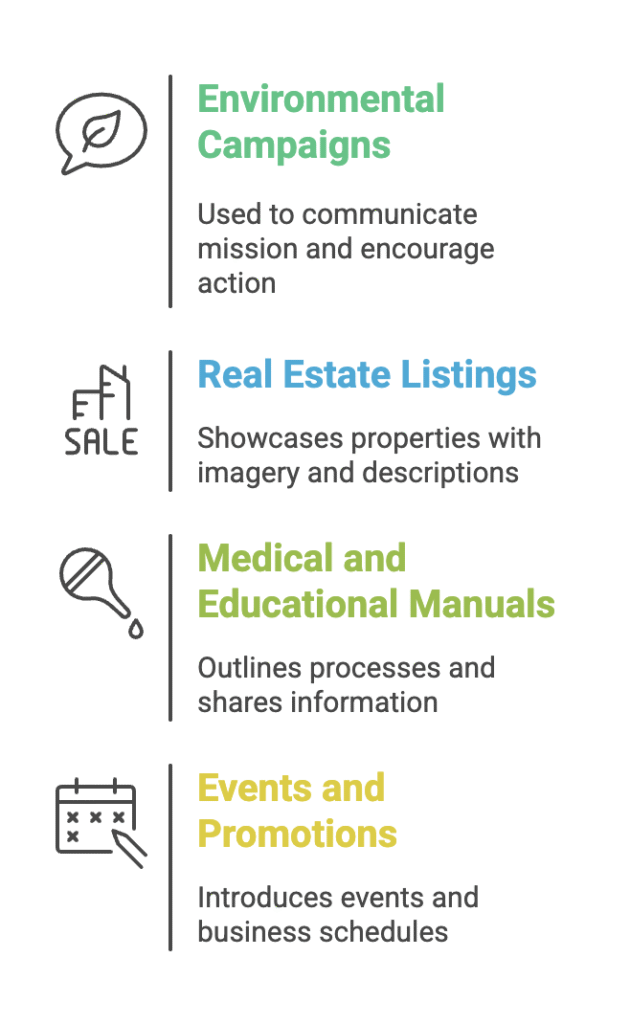
Brochures have established themselves as the perfect source, combining three elements: informative, attractive, and longevity’s through strategic designing to achieve a memorable impact.
What is a booklet brochure ?
Booklet brochures are a step up from standard folded brochures. Instead of being limited to just a few panels, they feature multiple pages bound together, often resembling a mini magazine or catalog. This extra space allows organizations to present comprehensive details about their products, services, or events all in one polished, organized document.
Uses of Booklet brochures
So, what do people actually use these things for? Tons of stuff:
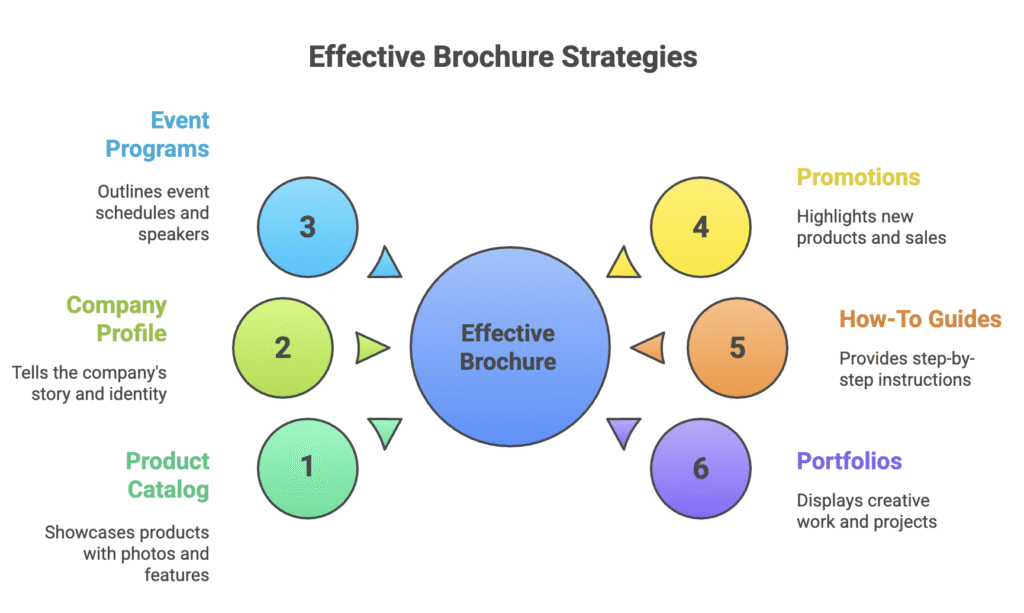
- Product or Service Catalog: Show off your products, services, you name it. Toss in some fancy photos, lists of features, maybe even a brag or two.
- Company Profile: Want to look legit? Here’s where you tell your story, who you are, why you exist, maybe even a cheesy team photo.
- Event Programs: Got a conference, seminar, or whatever? These little booklets lay out the schedule, introduce the speakers, and help people figure out where the heck they’re supposed to go.
- Promos: Launching something new? Running a sale? Booklet brochures are like, “Hey, look at this cool thing! Don’t miss out!”
- How-To Guides: Sometimes you just gotta walk people through stuff, step by step, with pictures, so nobody gets lost.
- Portfolios: Designers, photographers, agencies, anyone who wants to show off their work. It’s way classier than shoving a bunch of loose prints at someone.
Let’s be real nothing grabs your attention faster than glossy paper and colors that practically jump off the page. That’s why printers go all out with their booklet brochures. It’s not just about shoving info in people’s faces; it’s about making them stop, stare, and maybe even read what you’ve got to say.
These things show up everywhere, from your mailbox (where they somehow dodge the recycling bin) to being handed out at events by some poor intern who drew the short straw.
Whether you’re showcasing your company’s full range of services or providing guests with all the details for an upcoming event, booklet brochures are the tool of choice for organizations aiming to inform, impress, and persuade.
What content is typically included in a brochure?
A well-designed brochure packs a punch by organizing all the essential details a curious reader needs. Typically, you’ll find several key sections inside:
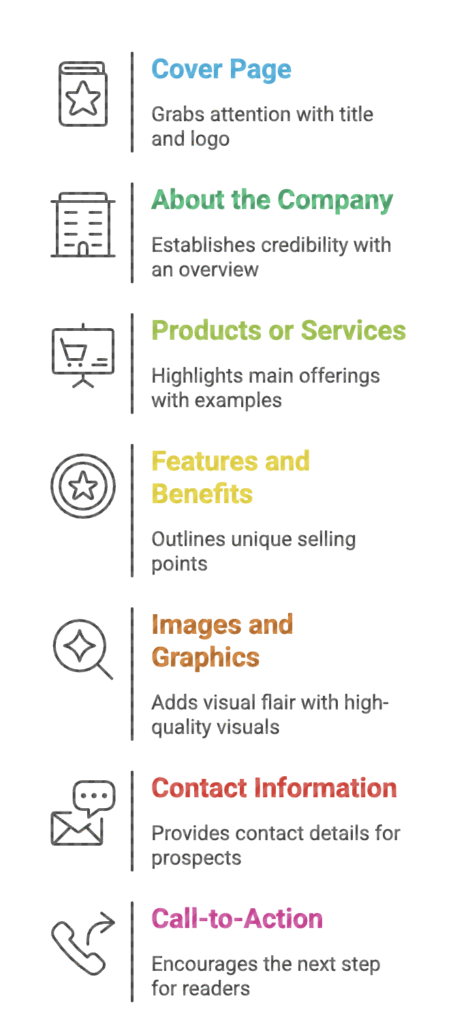
- Cover Page: Grabs attention with an engaging title and usually includes the company’s name, logo, and sometimes a tagline or mission statement.
- About the Company: Offers a brief overview of who you are and what you do, helping establish credibility from the start.
- Products or Services: Highlights your main offerings, often with dedicated sections for each think of a travel agency’s vacation packages, a real estate firm’s listings, or a non-profit’s programs.
- Features and Benefits: Clearly outlines what makes your offering stand out, often using bullet points or quick summaries for easy reading.
- Images and Graphics: Includes high-quality photos, infographics, or illustrations for visual flair automotive brochures, for example, will often showcase vehicles from dramatic angles, while tech firms may use diagrams or charts.
- Contact Information: Typically placed towards the back or on the inside flap, it tells prospects how to get in touch, phone numbers, email addresses, website URLs, and physical locations.
- Call-to-Action: Encourages the reader to take the next step, whether it’s calling for a quote, visiting a showroom, or signing up for an event.
Brochures often marry these sections with engaging headlines, catchy slogans, and concise, benefit-driven language. The aim is always the same: make information digestible and appealing at a glance, ensuring readers walk away with your brand top-of-mind.
What is an Infographic Brochure?
An infographic brochure takes the information ability of a typical brochure and converts it into a visually interactive form loaded with illustrations, graphics, and charts. Instead of having blocks of text, these brochures utilize design elements to dissect complex facts, enabling readers to absorb and remember the essential information much better.
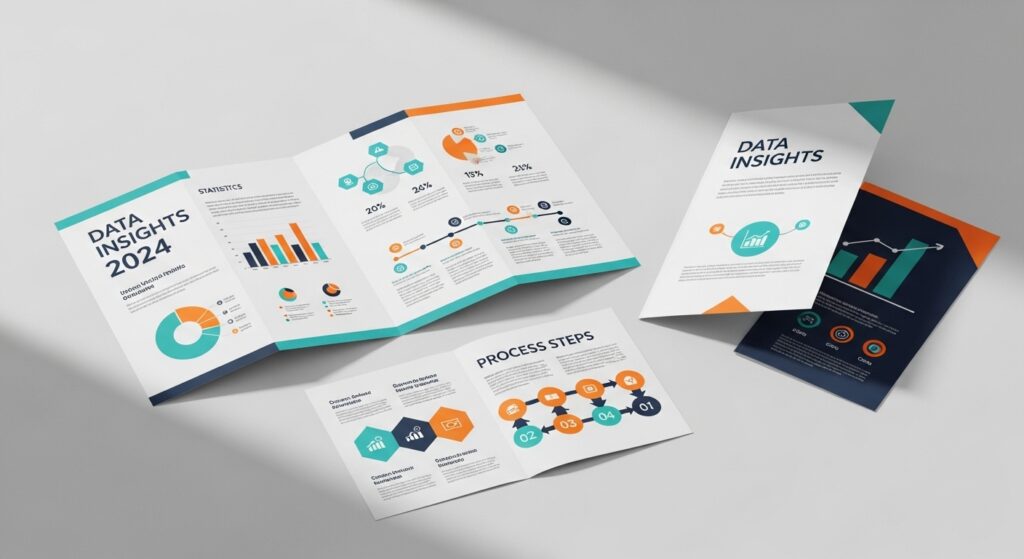
Businesses often use infographic brochures when they need to present data, showcase timelines, or explain processes, think annual reports, product launches, or event highlights. The combination of bold visuals and concise messaging helps capture attention quickly, ensuring important points don’t get lost in lengthy paragraphs.
Infographic brochures are especially useful in situations where you want to create immediate impact. Whether handed out at trade shows, included in media kits, or shared digitally for maximum reach. By blending eye-catching design with essential information, this format turns important content into an easy-to-read, memorable experience for the audience.
Pamphlet vs Brochure – Key Differences
Both pamphlets and brochures are vital promotional tools for any business. Both have different goals and can use them according to the product, target audience and marketing strategy. Listed below are a few significant points that will help you understand pamphlet vs brochure differences in a better way.
- Printers typically produce pamphlets on a single sheet of paper, sometimes folding them once (bi-fold) or twice (tri-fold). In contrast, they create brochures as mini booklets, often binding them or adding multiple folds to include detailed content and images.
- Small businesses often use pamphlets to raise public awareness or as part of an advertising strategy. In contrast, companies use brochures primarily for promotion and direct selling.
- Pamphlets cover information on a single topic in detail, while brochures are a comprehensive analysis of the organization that covers all the products and services offered. It also has relevant pictures to make it look inviting.
- Pamphlets are cheap and easy to print, whereas brochures need more resources and planning.
- People usually distribute pamphlets along with newspapers or hand them out outside public places like theaters or stadiums. In contrast, businesses typically give brochures to attendees at large-scale events or conferences.
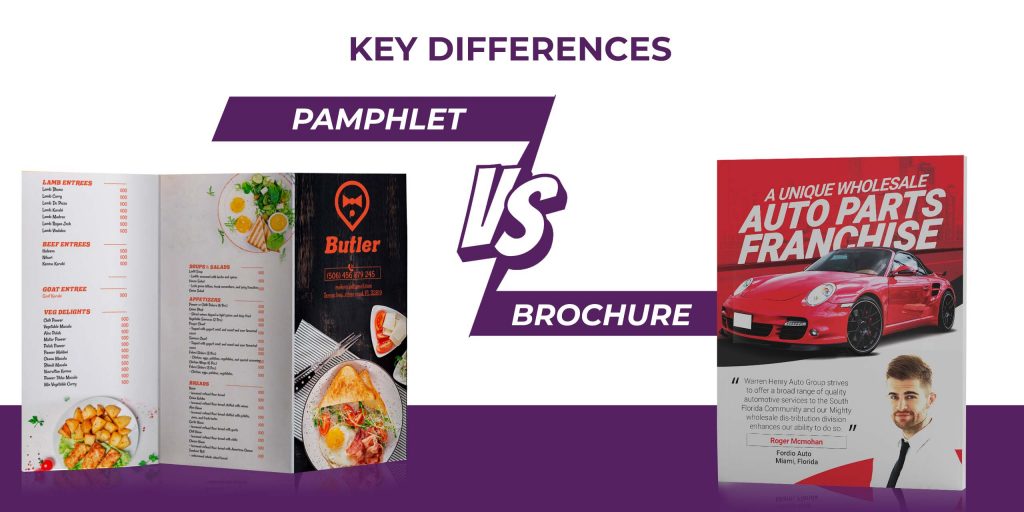
When planning your marketing strategy, you should have the right mix of pamphlets and brochures, as both help build brand recognition. In the next segment, we will focus on the various pamphlets and brochures you can create to present your company’s statistics.
Types of pamphlets and brochures formats
Both pamphlets and brochures have identical drafts, and the beauty is you can use any of them to your advantage to fulfill your company’s marketing goals. Listed below are the different types of pamphlets and brochures.
Gatefold Brochure & Pamphlet Template
A gatefold divides the paper into three parts, with the two outer panels folding inward to meet in the center. The left part is the front, and the right one is the back. A gatefold pamphlet caters to simple product descriptions. The standard size for this type of template is 8.5-x11”.
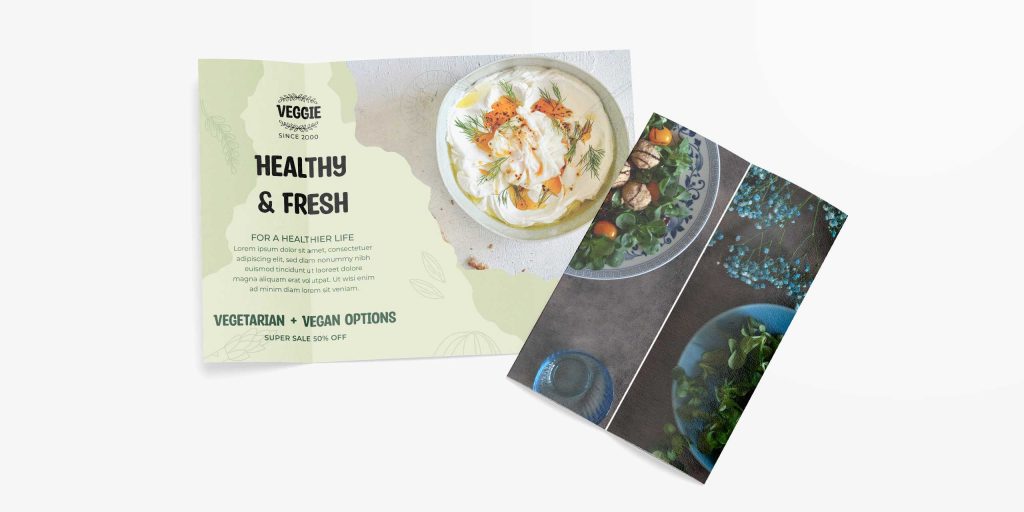
Trifold Brochure & Pamphlet Template
As the name suggests, a trifold divides a single sheet of paper equally into three sections. This template is suitable for displaying business details and services offered. It is a great printing option to showcase a mix of design and content. The standard size for this type of template should be 8.5”x11”.
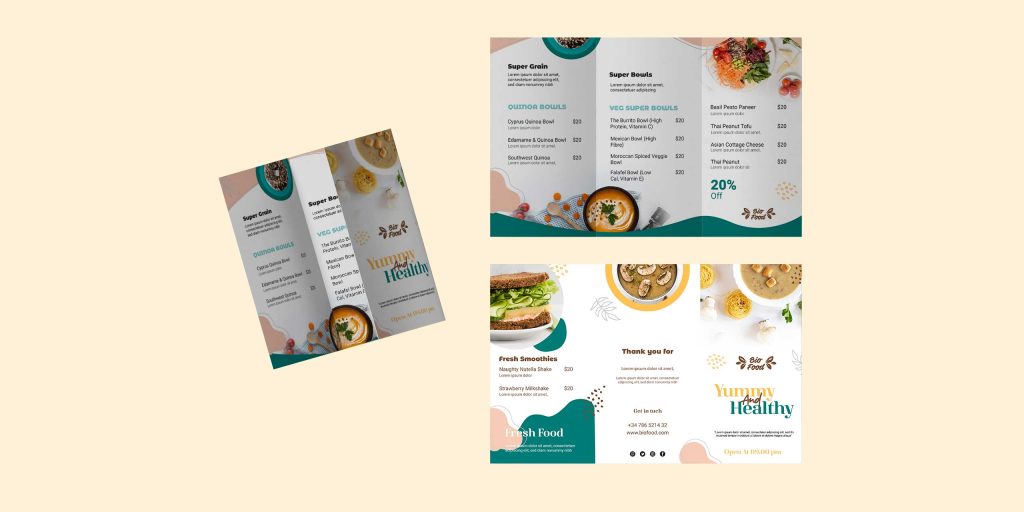
Z fold Brochure & Pamphlet Template
A befitting option for general descriptions Z fold has four folds and takes the shape of Z when opened. All the panels overlap each other. You can design Z fold in a single side or double side. The standard size of the template is 8.5”x11” in length and up to 24” in width.
Accordion fold Brochure & Pamphlet Template
In this format, the paper folds into four panels and opens up in shape of an accordion. This is suitable for providing step-by-step instructions. Accordion folds typically have a length of 8.5”x14”.
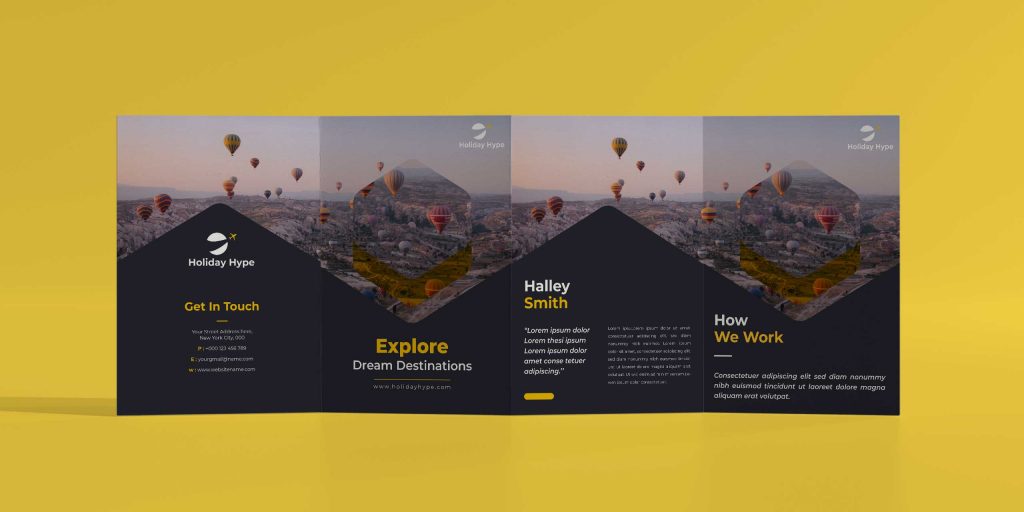
Bifold Brochure & Pamphlet Template
A bi-fold folds the paper in half. You will get four printable sides; Front, back, and two insides. It is an appropriate option for simple product descriptions or explaining a single subject. You can design this document as a single page or a multi-page booklet.
You can also include pockets inside a bi-fold brochure to insert your business card or other important information.
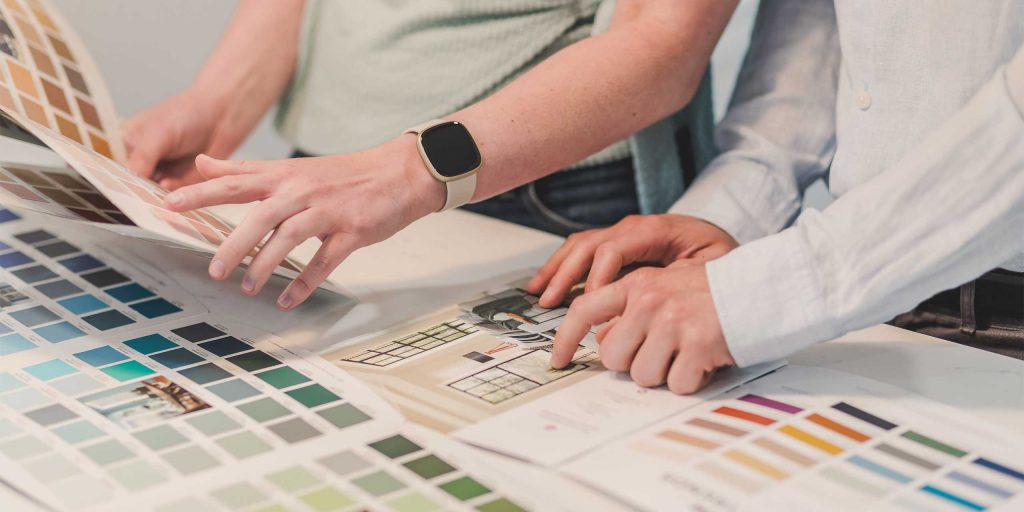
French bold fold Brochure & Pamphlet Template
Also known as the right angle fold, the french bold fold is applicable for both, pamphlets and brochure. In this, you fold the paper in half two times. The second time has to be perpendicular to the first. This is suitable mainly for travel brochures and event invitations. French bold folds have a standard length of 8.5”x14”.
You can decide on any of the templates mentioned above to advertise or promote your company, institution, shop, or organization. There are a few things to keep in mind.
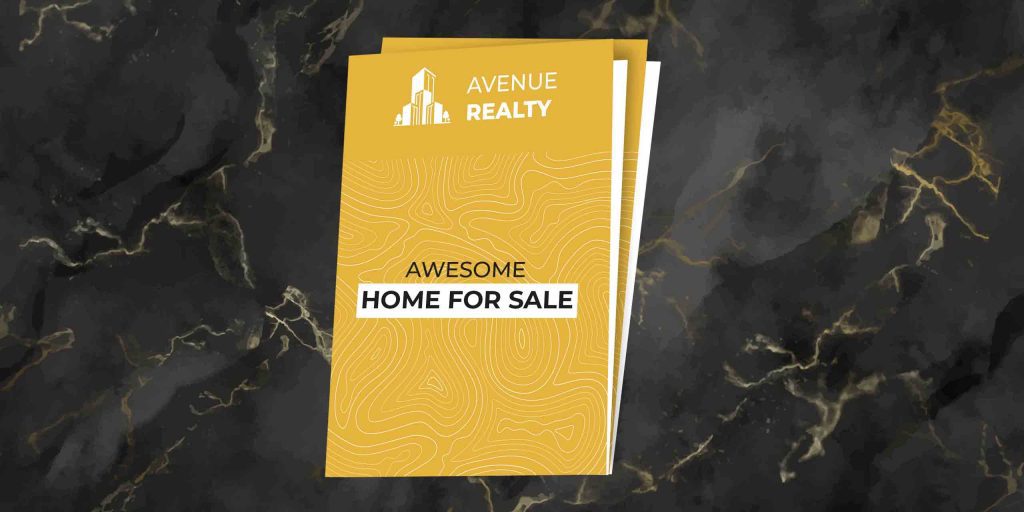
- Generally, pamphlets or brochures have a standard length of 8.5”x11”.
- The front page will have the name, logo, and topic heading it aims to cover.
- The inside will have the message in detail.
- The back panel is for printing contact information or any call-to-action messages.
- For pamphlets, you can take any plain inexpensive paper, but for brochures, you should have high quality, preferably glossy paper, to get the most impact.
Once you have zeroed in on the template type, you need to work on the content and images. Read the following section for a step-by-step account of what a pamphlet or brochure should include.
How to design a pamphlet or brochure
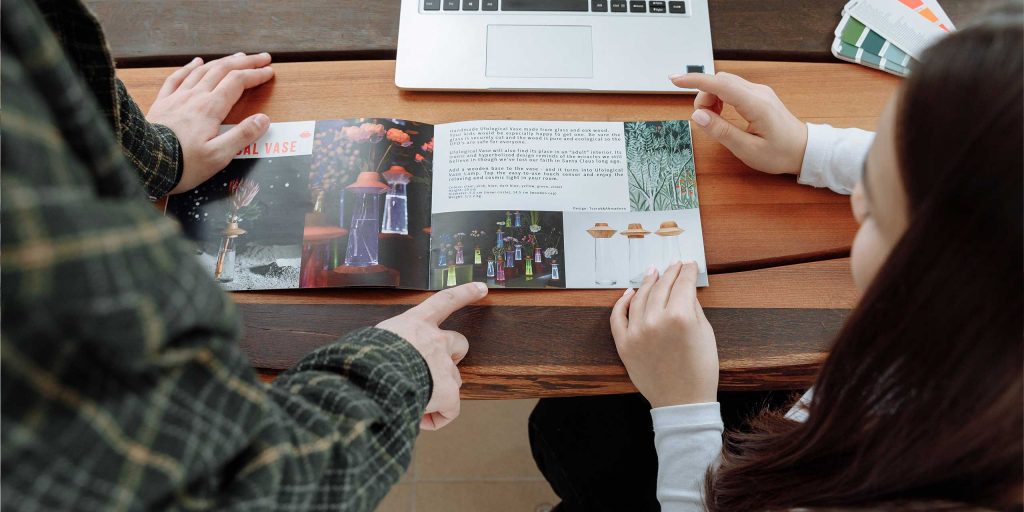
- Know Your Purpose & Audience
Define the goal and who you’re speaking to. This ensures your message stays focused and relevant. - Research Thoroughly
Gather accurate info from credible sources to support your content. - Plan the Layout & Headline
Decide your structure early. Use a compelling headline- e.g., for real estate: “The High Life.” - Write Short, Clear Content
Use simple, impactful language. Keep sentences brief and easy to grasp. - Use Visuals Strategically
Add relevant, high-quality images, charts, or icons. Always test print quality. - Craft a Memorable Tagline
Think “Just Do It” (Nike) or “Eat Fresh” (Subway). Keep it catchy and brand-aligned. - Include Your Logo & Brand Name
Ensure your brand identity is visible and consistent across materials. - Avoid Common Design Mistakes
- Don’t clutter with excessive text.
- Leave white space to avoid visual overload.
- Proofread for typos and run test prints.
- Link to Extra Info
Use website or FAQ links if you have more to say, instead of overcrowding.
Sizes and Fold Types
Pamphlets and brochures come in a variety of sizes and folds depending on your content and marketing needs. Here’s a breakdown:
Common Fold Types:
- Bi-Fold:
- Folds in half, creating 4 panels (2 on the front, 2 on the back).
- Ideal for simple product or service overviews.
- Common size: 8.5” x 11” (letter size).
- Tri-Fold:
- Divides a sheet into three panels.
- Very popular for promotional pamphlets or brochures.
- Standard size: 8.5” x 11” (folded into thirds).
- Z-Fold (Accordion Fold):
- Opens like an accordion with 3 or more panels.
- Great for step-by-step guides or storytelling.
- Common sizes: 8.5” x 11”, 11” x 17”.
- Gatefold:
- Two end panels open to reveal a larger central panel.
- Works well for high-impact presentations or event brochures.
- Size varies depending on design, often 8.5” x 11” or larger.
Key Takeaways
- Pamphlet vs Brochure Leaflets are simple and subject specific, brochures are colorful, multi-paged marketing material.
- Pamphlets: Good for raising awareness, community events, public health information or getting out the vote; inexpensive to print and distribute.
- Pamphlets: For the promotion of products, services, events, company profiles; to drive the attention, knowledge and motivation of prospects.
- Booklet Brochures: Mini-magazine form with multiple pages, great for product catalogs, magazines, portfolio booklets, event programs and other marketing materials.
- Infographic Brochure: Graphic-first layout with charts, icons, and visuals; great for sharing data, timelines or processes.
- Design Tip: Limit the amount of text, leverage visuals to sell and “always include a prominent call-to-action or contact info.
- Pro Strategy: Go with pamphlets for short-term outreach and brochures for long-term brand impressions.
Conclusion
We hope this article has been helpful for you to understand what is a pamphlet and a brochure along with the key difference between pamphlets and brochures, i.e., pamphlet vs brochure. To summarize, pamphlets are ideal when you want to advertise or create awareness about a single topic, and brochures are practical for showcasing comprehensive information for marketing or advertisement.
Whatever you decide, you can always count on experts like Design Shifu for all your graphic design requirements. Not to forget, you can always pick from our subscription packages that best meet your needs and budget. What’s more, these subscriptions come with 24×7 support, unlimited revisions and a 100%, 14-day money-back guarantee!
FAQs
What is a brochure and how does it differ from a pamphlet?
A brochure is a structured, visually appealing printed material that provides detailed information about a product, service, or event. It is usually folded and presents information in an organized layout. While a pamphlet is more concise and informational, a brochure is designed to captivate the reader with its aesthetics and comprehensive content.
How are pamphlets typically used?
What are some examples of pamphlets?
How can a well-designed pamphlet benefit my marketing strategy?
How does a brochure enhance marketing efforts?
What’s the ideal length for a pamphlet or brochure?

![What is a pamphlet? Pamphlet vs Brochure explained [With Examples]](https://designshifu.com/wp-content/uploads/2022/10/Cover-Image.jpg)

